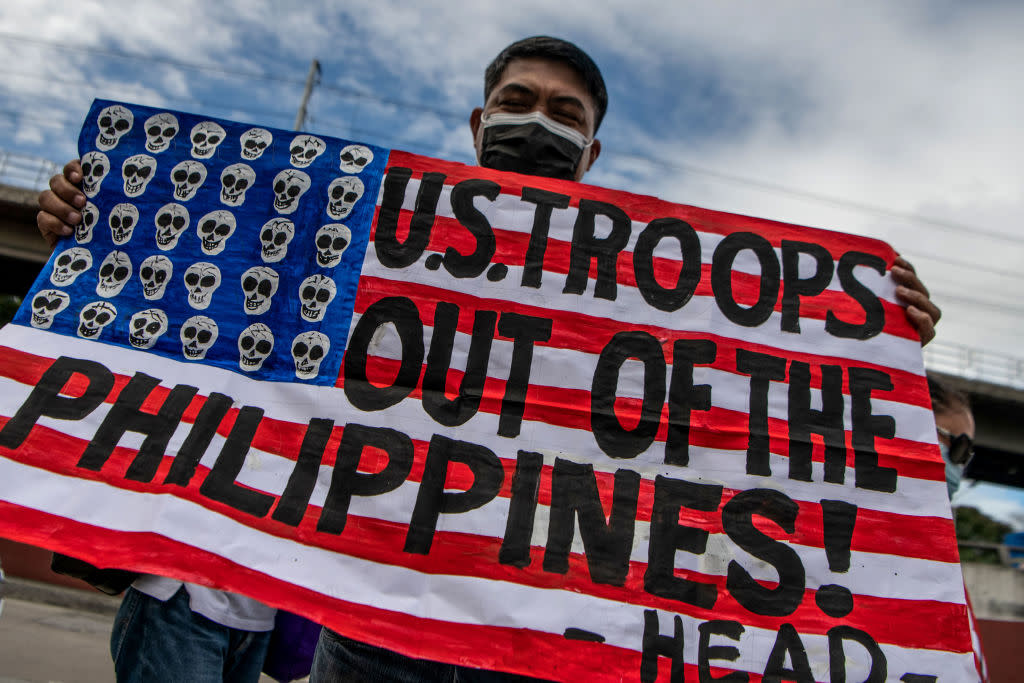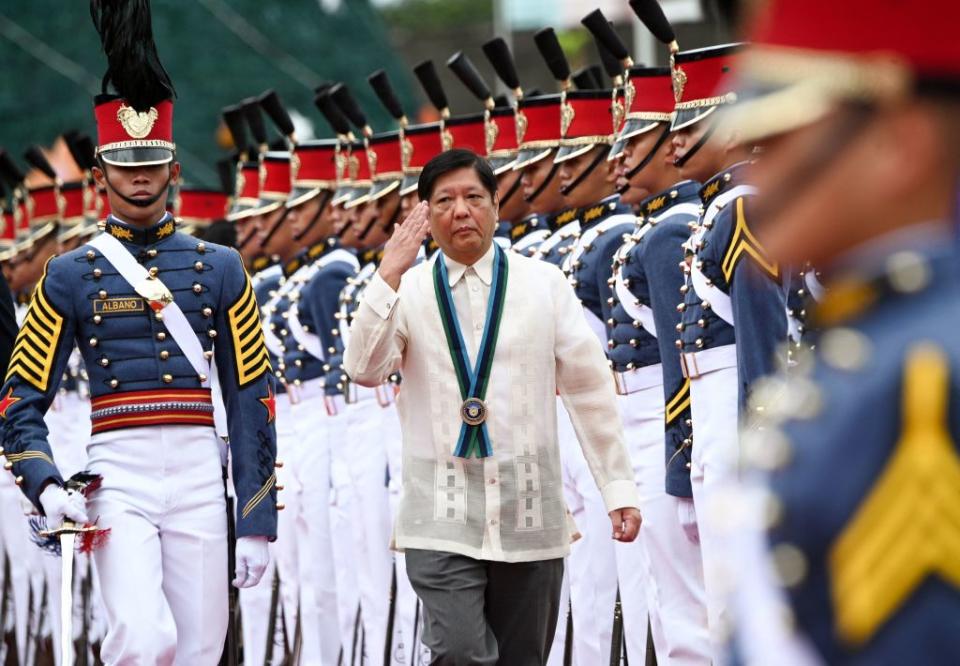Why the Philippines Is Letting the U.S. Expand Its Military Footprint in the Country Again

Activists stage a protest outside Camp Aguinaldo, military camp, on Feb. 2, 2023 in Manila, Philippines. Credit - Jes Aznar—Getty Images
It’s been more than 30 years since Philippine lawmakers moved to end the permanent U.S. military presence in the country. Previously, the U.S. operated two major bases, but many Filipinos saw the bases as a legacy of U.S. colonialism, and wanted to assert their independence.
Now, the Philippines is inviting the U.S. to increase its military footprint in the country again—giving access to four new military bases amid rising tensions with China, the two countries announced Thursday.
“By itself, the Phillipines cannot stand up to China so it does need the assistance of the United States,” says Kenneth Faulve-Montojo, an expert on Filipino politics and senior lecturer at Santa Clara University. “So from the U.S. and the Philippine perspective, it appears to be a win, win situation.”

The acceleration of the Enhanced Defense Cooperation Agreement would grant the U.S. access to four more military bases in the Philippines; the U.S. already had access to five, including sites in Palawan, Pampanga, Nueva Ecija, the Visayas, and Mindanao.
The increased access to more bases “will make our alliance stronger and more resilient, and will accelerate modernization of our combined military capabilities,” the U.S. Defense Department said in a Feb. 1 statement. There are currently about 500 U.S. military personnel in the Philippines.
The U.S. also said that the expanded base access would allow “more rapid support for humanitarian and climate-related disasters in the Philippines” as well as foster economic growth through foreign investments and job creation. While many Filipinos may welcome American presence as a strategic way to counter and deter Chinese influence and incursions, others may still be wary of the social implications of granting the U.S. military so much power on their land.
U.S. Defense Secretary Lloyd J. Austin III said at a news conference the development was a “big deal” but stressed that the deal did not mean the U.S. was reestablishing permanent American bases on the archipelago. The U.S. formally ended its 94-year military presence in the area in the early 1990s, shutting down Clark Air Base and Subic Bay Naval Base after the Philippine Senate rejected a treaty that would extend American military presence in exchange for aid.

The locations of the additional military bases the U.S. will now have access to have not been publicly disclosed but the two countries had previously discussed new sites in the northern province of Cagayan, across the strait from Taiwan, and in Palawan and Zambales, according to the Associated Press.
The agreement also comes after last year’s election brought new leadership to the Philippines and helped solidify Filipino President Ferdinand “Bongbong” Marcos Jr.’s “radical shift in foreign policy,” says Diane A. Desierto, professor of law and global affairs at the University of Notre Dame.
His predecessor Rodrigo Duterte had a much more anti-U.S. and pro-China stance; Duterte previously threatened to kick the U.S. military out of the country, but reversed course as a “concession” for vaccine donations. “It signals that the current president is interested in a balancing policy that recalls the long history of strategic cooperation between the United States and the Philippines,” Desierto says.
Military implications
The U.S. has been focused on containing China’s expansion and protecting Taiwan—so its increased presence in Asia is likely to send a signal to the regional superpower. “Because of U.S. presence, China has to be a lot more delicate in where it steps because obviously Chinese and U.S. personnel cannot be involved in a military conflict,” Faulve-Montojo says.
Geographically, the Philippines is in a key strategic area for the U.S.. “That archipelago is guaranteed to give the United States a kind of strike capability that the base in Okinawa or the base in Thailand is unable to give,” Desierto says. “Its access to the main waterways in the South China Sea enables flexibility for U.S. troops and enables multiple theaters of engagement for the U.S., not just in Northeast Asia, but also Southeast Asia.”
The U.S. agreement with the Philippines also follows other recent commitments with Asian countries; on Jan. 11, the U.S. declared that it would strengthen its alliance with Japan to counter Chinese and North Korean influence. The U.S.-Philippines deal would also benefit Japan and South Korea’s security, experts note, by further deterring Chinese aggression in the region. “The good part [for the other countries] is that it’s on someone else’s territory; they benefit without paying the costs,” Faulve-Montojo says.
But China is not happy about the U.S.-Philippines deal, criticizing it as “selfish.”
“The U.S. has adhered to a Cold War zero-sum mentality and strengthened military deployment in the region,” Chinese Foreign Ministry spokeswoman Mao Ning told reporters at a daily briefing on Thursday. “This is an act that escalates tensions in the region and endangers regional peace and stability.”
The regional tension most at risk of escalation is the status of Taiwan. China’s increasingly aggressive stance towards the self-ruling island has added urgency for regional neighbors and the U.S. to push back. Experts note that armed conflict over the island could be feasible in the near future. In a sensational memo to troops last week, a Four-Star U.S. General predicted America would be at war with China over Taiwan by 2025.
China has also come under fire for breaching international obligations in relation to the Philippines when it comes to environmental protection, fisheries cooperation, and freedom of navigation, Desierto adds. “To the extent that the Philippines is now welcoming the larger American military presence; that also sends them a signal that the breaches will not be tolerated or will not be ignored the way they were in the previous administration.”
Reservations about increased U.S. military presence
After the announcement of the new agreement, protesters gathered outside of the Philippine military headquarters, expressing concern that the move unnecessarily puts the Philippines in between two superpowers at odds with each other.
“Filipinos do not need additional American troops and facilities in the country. It will only serve to increase the tensions in the South China Sea and the Taiwan Strait. And deploying additional facilities and troops in the Philippines will drag the country into the conflict, which is between China and the United States,” Teddy Casiño, a former member of the Philippine House of Representatives, told Democracy Now.
Faulve-Montojo says that many protesters are also worried that increasing the U.S. military presence could signify a new encroachment on the Philippines’s autonomy. “Their argument is that you’re getting back to the way things were, the old system. In that context, you are surrendering Philippine sovereignty, and the Philippines now is becoming nothing more than a puppet for the United States.”
Experts note that many Filipinos consider the decision to be a double-edged sword: increased American presence will bring with it a boost to the economy but also greater potential for conflict between the military and locals that often goes unchecked. “Sometimes the U.S. servicemen do things that they’re not supposed to do,” says Faulve-Montojo, who adds that American soldiers are often protected by the United States when incidents, such as rape, happen. Vicente Rafael, a history professor at the University of Washington, says that soldiers have been accused of acting “above the law” in their host countries.
“There’s a history of conflict between the U.S. forces and local people. It’s the local people who have suffered the consequences of any kind of abuse or crime.”
The Philippines colonial history
American presence in the Philippines has a thorny legacy. Experts say that the heavy hand the U.S. exerted in shaping the modern country could influence public perception on the new deal. The U.S. colonial rule between 1898 and 1946 resulted in an asymmetrical relationship between the two countries that still persists today, says Rafael.
“The Philippines is economically dependent on its trade relations with the United States,” says Rafael. “The military is totally dependent on the U.S. for training, second-hand weapons, and advice.”
The U.S.’s strategic military involvement with the Philippines goes back to the turn of the century, when the U.S. assumed control of the Philippines from Spain. “The U.S. organized a native, colonial militia to help them put down the Philippine Revolution that was raging at the time,” says Rafael, “It evolved into the military defense force that works with the United States, especially in relation to internal threats.”

English-language public schools were established throughout the country, along with a civil government, and an import substitution economy was introduced that kept Filipinos dependent on U.S. support. “The Philippines was not able to produce its own goods for its own use,” says Richard Chu, a history professor at the University of Massachusetts, Amherst. “It made the Philippine economy dependent on the U.S. economy.”
But not everyone is resentful. “Schools in the Philippines focused on American history and Western culture instead of Filipino culture and history,” says Chu. “A generation of Filipinos were educated to think that U.S. colonization was good for the country.”
“Even today with the military bases being established, many Filipinos would support that because they think of China as the enemy, and the U.S. having the Philippines’ best interest.”


